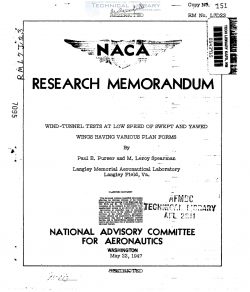naca-rm-l7d23
- Version
- 198 Downloads
- 2.51 MB File Size
- 1 File Count
- March 14, 2017 Create Date
- March 14, 2017 Last Updated
National Advisory Committee for Aeronautics, Research Memorandum - Wind Tunnel Tests at Low Speed of Swept and Yawed Wings Having Various Plan Forms

Wind-tunnel tests of an exploratory‘nature_have been made at
low speed of various small-scale models of swept- back, swept-
forward, and yawed wings. The tests covered changes in aspect
ratio, taper ratio, and tip shape. Some data were obtained with
high- lift devices on swept-back wings and with ailerons on swept-
forward wings. The data have been briefly analyzed and some
comparisons have been made with the available theory.
The results of the tests and the analyses indicated that the
values of lift-curve slope and effective dihedral of swept wings
can be computed with a reasonable degree of accuracy in the low-
lift-coefficient range by means of existing theories.
In general, reducing the aspect ratio and the ratio of root
chord to tip chord resulted in increases_in drag_and effective
dihedral and increased the longitudinal stability near the stall.
Cutting off the tip of a swept-back wing normal to the leading edge
reduced the effective dihedral at low lift coefficients and gave
a slight reduction in the drag at high lift coefficients.
Wind-tunnel tests of an exploratory‘nature_have been made at
low speed of various small-scale models of swept- back, swept-
forward, and yawed wings. The tests covered changes in aspect
ratio, taper ratio, and tip shape. Some data were obtained with
high- lift devices on swept-back wings and with ailerons on swept-
forward wings. The data have been briefly analyzed and some
comparisons have been made with the available theory.
The results of the tests and the analyses indicated that the
values of lift-curve slope and effective dihedral of swept wings
can be computed with a reasonable degree of accuracy in the low-
lift-coefficient range by means of existing theories.
In general, reducing the aspect ratio and the ratio of root
chord to tip chord resulted in increases_in drag_and effective
dihedral and increased the longitudinal stability near the stall.
Cutting off the tip of a swept-back wing normal to the leading edge
reduced the effective dihedral at low lift coefficients and gave
a slight reduction in the drag at high lift coefficients. Sweeping
forward a part of the outer panel of a swept-back wing improved the
longitudinal stability and decreased the effective dihedral but also
slightly decreased the maximum lift coefficient and increased the
drag at high lift coefficients. The use of high-lift devices at
either the leading edge or the trailing edge of swept-back wings
increased the lift- drag ratio and the effective dihedral at high
lift coefficients. An increase in the ratio of root chord to tip
chord for swepteforward wings gave decreases in aileron rolling-
moment effectiveness that were greater than the values computed for
unswept wings.
Sweeping
forward a part of the outer panel of a swept-back wing improved the
longitudinal stability and decreased the effective dihedral but also
slightly decreased the maximum lift coefficient and increased the
drag at high lift coefficients. The use of high-lift devices at
either the leading edge or the trailing edge of swept-back wings
increased the lift- drag ratio and the effective dihedral at high
lift coefficients. An increase in the ratio of root chord to tip
chord for swepteforward wings gave decreases in aileron rolling-
moment effectiveness that were greater than the values computed for
unswept wings.
| File | Action |
|---|---|
| naca-rm-l7d23 Wind Tunnel Tests at Low Speed of Swept and Yawed Wings Having Various Plan Forms.pdf | Download |

Comment On This Post